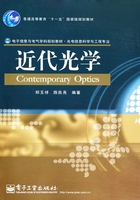
上QQ阅读APP看本书,新人免费读10天
设备和账号都新为新人
1.3 高斯光束[10~12]
稳态传播的光波满足亥姆霍兹方程,柱面坐标系中的亥姆霍兹方程为

设光主要沿z方向传播,电场复振幅沿z方向缓慢变化。在缓变振幅近似下的解为

所谓缓变振幅近似,即

将式(1.3-2)代入方程(1.3-1),并利用缓变振幅近似,忽略对坐标z的二阶导数,得到

在z=0处,振幅为

设试解为

其中,函数f1(z)和f2(z)满足

将试解(1.3-6)代入式(1.3-4)得


其中

式中

Z0称为瑞利范围或瑞利长度。将式(1.3-9)代入试解(1.3-6),得高斯光束的复振幅为

或

于是,高斯光束的电场强度可写为

下面介绍式(1.3-13)中参量w(z)、R(z)、φ的意义。
1.3.1 高斯光束的束宽与远场发散角
在z为常数的平面内,高斯光束的场振幅为

这是一个高斯函数。由高斯函数的性质可知,w(z)为场振幅下降到中心值1/e处的半径值,因此称为高斯光束的束宽。束宽w(z)随z变化,具有以下形式

或

可见,束宽按双曲线规律向外发散。在z=0处,w(0)=w0为最小值,称为束腰。引入远场发散角θ0,定义为

1.3.2 高斯光束的等相面曲率半径
高斯光束的等相面方程为

这里

在傍轴条件下,φ(z)可以略去,故有

除z=0面外,等相面为抛物面。上式也是原点在(0,0,a)、半径为R的球面方程的傍轴形式,即

当z=0时,R→∞,等相面为平面;当z≪Z0时,R~ /z,等相面近似为平面;当z=±Z0时,R=2Z0,取极小值;当z≫Z0时,R→z,在远场可看作由z=0点发出,半径为z的球面波。
/z,等相面近似为平面;当z=±Z0时,R=2Z0,取极小值;当z≫Z0时,R→z,在远场可看作由z=0点发出,半径为z的球面波。
1.3.3 高斯光束的纵向相位因子
高斯光束的纵向相位因子为φ=arctanz/( Z0),总相移为

它表示高斯光束在点(r,z)处相对于点(0,0)处的相位差。其中kz为几何相移,kr2/[2R(z)]为与
径向相关的相移,φ=arctanz/( Z0)为高斯光束经传播距离z后相对几何相移产生的附加相移。